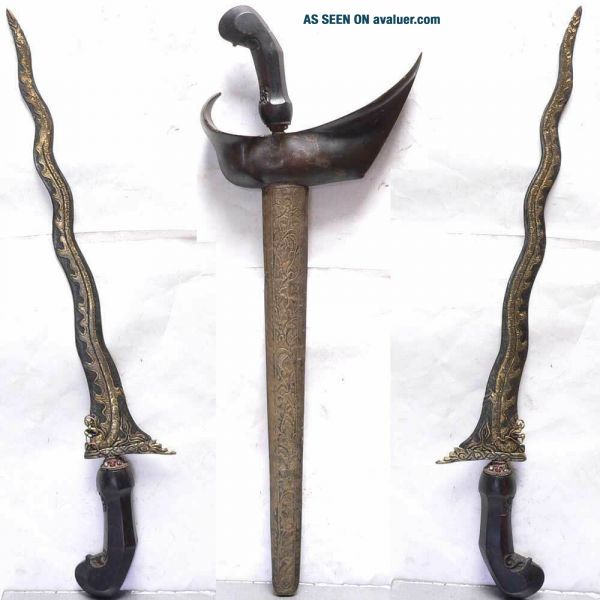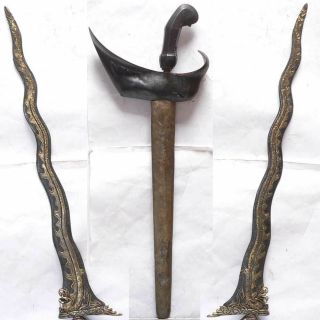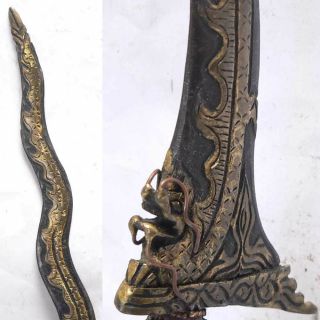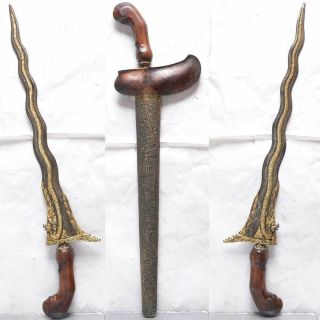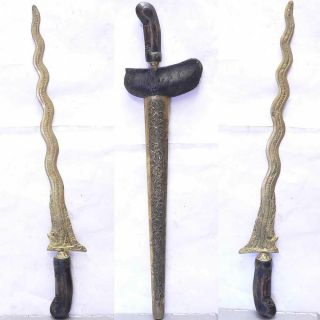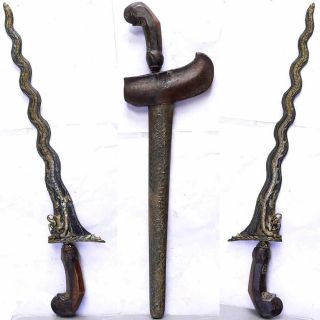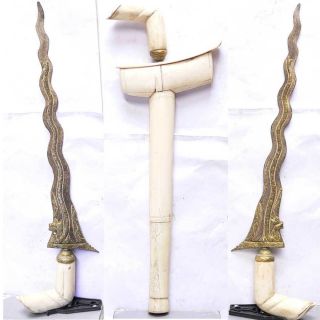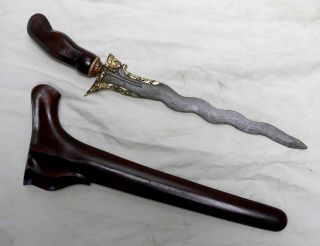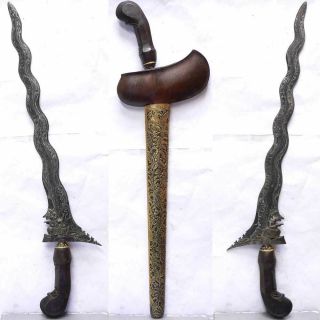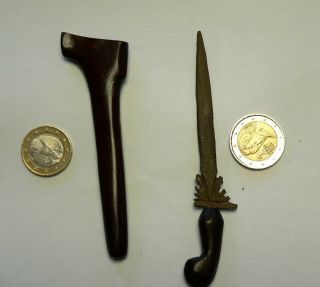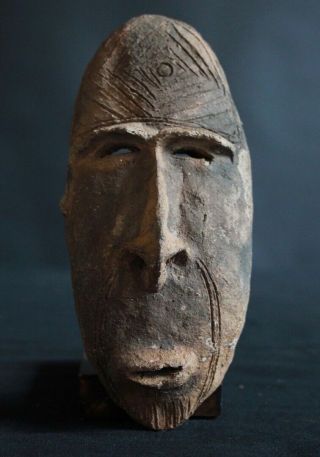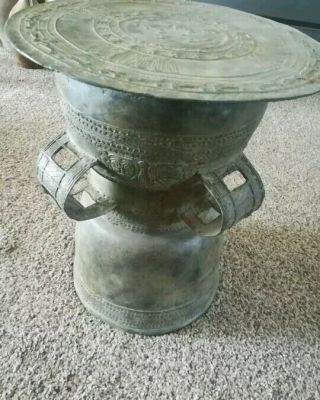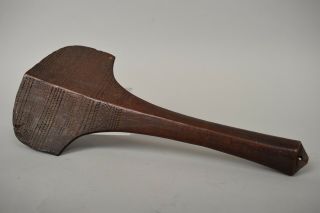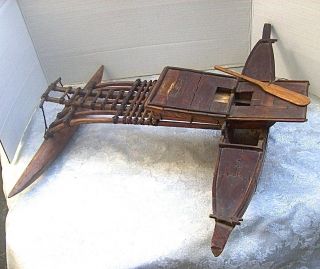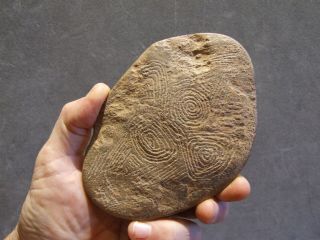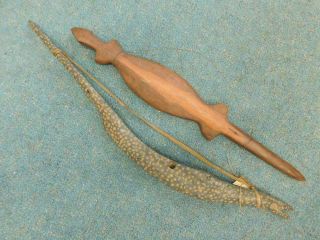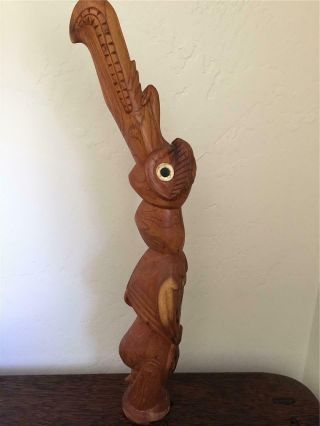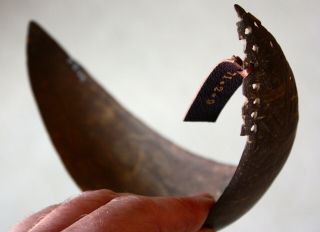9 Lok DRAGON KRIS Keris NAGA Blade Magic Sword Java Indonesia Tribal Art
Item History & Price
| Reference Number: Avaluer:27710574 | Original/Reproduction: Original |
| Country of Origin: Indonesia | Category: Antiques Ethnographic |
| Asian Culture: Indonesia |
Indonesian keris (kris) .
I'm selling a collection of old Indonesia goods, mainly weapons and statues. This one was labelled "9 lok Naga kris uit Oost Java" ( dragon kris with 9 curves from the east part of Java)
I found on the internet about naga: In Javanese and Balinese culture, Indonesia, a Naga is depicted as a crowned giant magical serpent, sometimes winged. It is similarly... derived from the Shiva-Hinduism tradition, merged with Javanese animism. Naga in Indonesia mainly derived and influenced by Indic tradition of Naga serpent, combined with native animism tradition of sacred serpent.The early depiction circa 9th century Central Java closely resembled Indic Naga which was based on cobra imagery. The later depiction since the 15th century however, was slightly influenced by Chinese dragon imagery, although unlike its Chinese counterparts, Javanese and Balinese nagas do not have legs. The concept of Naga is prevalent in the Hindu period of Indonesia, before the introduction of Islam. It is usually linked as the lesser deity of earth and water. In a wayang theater story a snake (naga) god named Sanghyang Anantaboga or Antaboga is a guardian deity in the bowels of the earth.[29][30] Naga symbolize the nether realm of earth or underworld.One of the specificity of the Keris is its connection with the serpent deity Naga. A Chinese monk, I- Ching, who lived in Java during the late 7th century noticed the local Buddhism possessed a unique characteristic: praying Naga deities. According to the tradition, the straight Keris represents a still serpent, whereas the wavy represent a moving serpent. The Naga is often represented on Keris blades.......The great nemesis of the nagas in the Mahabharata is the gigantic eagle-king Garuda. Garuda and the nagas began life as cousins. The sage Kashyapa had two wives (amongst his 13 wives, all prajapati Daksha's daughters), Kadru and Vinata, the former of whom desired many offspring, and the latter of whom desired few but powerful offspring. Each got her wish. Kadru laid 1000 eggs which hatched into snakes, and Vinata laid two, which hatched into the charioteer of Surya the sun god and Garuda. Through a foolish bet, Vinata became enslaved to her sister, and as a result Vinata's son Garuda was required to do the bidding of the snakes. Though compliant, he chafed and built up a grudge that he would never relinquish. When he asked the snakes what he would have to do in order to release his mother, Vinata, from her bondage, they told him he would have to bring them amrita, the elixir of immortality. Garuda stole the elixir from the gods and brought it to the serpents in fulfillment of their requirement, but through a ruse prevented them from partaking of it and achieving immortality. From that point onward, he regarded them as enemies and as food. (Book I: Adi Parva, Sections 16ff.)[citation needed]
I found on the internet about 9 lok:
Keris Lurus (straight Keris) and Keris Luk (curved keris) Dapur
Dapur or shape is the keris specific form or type and identified by particular combination of parts and curved (luk). The meaning of dapur is based on certain standard which is called Pakem Dapur Keris…B.Keris Luk or Keris with Curved Luk 3 : symbolizing a success to achieve some wishes.
Luk 5 : to be loved by other people
Luk 7 : dignity.
Luk 9 : dignity, charismatic and leadership.
Luk 11 : to achieve high position
Luk 13 : peaceful and stability of live.
I found on the internet about East Java:..East Java (Indonesian: Jawa Timur, abbreviated as Jatim, Javanese: ꧋ꦗꦮꦮꦺꦠꦤ꧀, romanized: Jåwå Wétan, Madurese: جاوه تيمور, romanized: Jhâbâh Dhimor)[7] is a province of Indonesia. It has a land border only with the province of Central Java to the west; the Java Sea and the Indian Ocean border its northern and southern coasts, respectively, while the narrow Bali Strait to the east separates Java from Bali.Located in eastern Java, it also includes the island of Madura, which is connected to Java by the longest bridge in Indonesia, the Suramadu Bridge, as well as the Kangean and Masalembu archipelagos located further east and north, respectively. Its capital is Surabaya, the second largest city in Indonesia and a major industrial center. Banyuwangi is the largest regency in East Java and the largest on the island of Java.....The province is inhabited by many different ethnic groups, such as the Javanese, Madurese and Chinese. Most of the people in East Java adheres to Islam, forming around 96% of the total population. Other religions are also worshipped, such as Christianity, which are mostly worshipped by Chinese Indonesians and immigrants from Eastern Indonesia and North Sumatra, and also Hinduism which are mostly worshipped by the Tenggerese people in the Bromo Tengger Semeru National Park and the Balinese people inhabiting the easternmost part of the province bordering Bali. The Indonesian language is the official language of the province as well as the whole nation, but Javanese and Madurese are the most frequently used language. Indonesian is only used for inter-ethnic communication and official purposes......The Dinoyo inscriptions found near the city of Malang are the oldest written sources in East Java, dating from 760 CE. They tell of many political and cultural events in the Kingdom of Dinoyo. The name of Malang is thought to come from the name of a sacred building called Malangkuseswara. This name is contained in at least one inscription, namely, the Mantyasih inscription written in 907 CE.In 1222, Ken Arok founded the Kingdom of Singhasari, which he ruled until 1292. Before coming to power, Ken Arok seized power in Tumapel (Kediri) from Tungul Ametung. Ken Arok dynasty's descendants became kings of Singhasari and Majapahit from the 13th until the 15th century.In 1227, Anusapati killed Ken Arok, and later became king of Singasari. Anusapati's power only lasted 20 years, before he was killed by Tohjaya. Three years later, Tohjaya was killed in the uprising led by Jaya Wisnuwardhana, son of Anusapati. In 1268, Wisnuwardhana died, and he was succeeded by Kertanegara (1268-1292). In 1292 Kertanegara was defeated by a rebel named Jayakatwang, ending the power of Kertanegara power and the history of Singhasari.In 1293, Kublai Khan, founder of the Yuan dynasty, sent a large invasion fleet to Java with 20, 000 to 30, 000 soldiers, beginning the Mongol invasion of Java.[13] This was a punitive expedition against King Kertanegara of Singhasari, who had refused to pay tribute to the Yuan and maimed one of its ministers. However, it ended with failure for the Mongols.In 1294, the Kingdom of Majapahit was founded. Its founder was Raden Wijaya. Majapahit reached its peak during the reign of Hayam Wuruk. He was accompanied by the mahapatih Gajah Mada. Together they managed to unite the vast territory under the name Dwipantara. Majaphit later developed to become one of the strongest empire in Southeast Asia.In 1357, the Bubat event occurred, the war between the King of Sunda and the Majapahit Patih Gajah Mada. This event stems from the desire to take the king Hayam Wuruk Sundanese princess named Dyah Pitaloka as queen. However, because of a misunderstanding about the procedure of marriage, the plan led to a battle in Bubat. Majapahit troops, under the command of Gajah Mada defeated Pajajaran. In 1389, Hayam Wuruk died, and was succeeded by Wikramawardhana. This resulted in the beginning of the decline of the Majapahit Empire. As the Majapahit Empire went into decline in the late 1300s, Islam moved to fill the vacuum.[14].....he precise date when Islam enters Java remains unclear. This is due to the absence of a definite source regarding the arrival of Islam in Java. However, according to some experts, it is estimated that Islam entered Java around the 11th century with evidence of the tomb of Fatimah Binti Maimun in the village of Leran in Gresik Regency which dates from 475 AH (1085 AD). The tomb also shows that in the 11th century the North coast of Java had begun to be frequented by Arab traders from the Middle East. In addition, several Islamic tombs were discovered in Trowulan, located in what is now part of the Mojokerto Regency, near the site of the former Majapahit palace.[15]On the 15th century, a Chinese Hui voyager named Ma Huan (simplified Chinese: 马欢; traditional Chinese: 馬歡; pinyin: Mǎ Huān) visited East Java. He then wrote the book Yingya Shenglan (simplified Chinese: 瀛涯胜览; traditional Chinese: 瀛涯勝覽; pinyin: yíngyá shènglǎn), which tells the story of the countries visited by him over the course of the Ming treasure voyages. He mentioned that at that time there were three different kind of people inhabiting Eastern Java: Arabs from the Middle-East, the ancestor of the modern Arab Indonesians; Chinese Muslims originating from the modern-day Guangdong province, and the native Javanese people.[16]By the 16th century, the Majapahit Empire was defeated by the Islamic kingdoms in Java, resulting in the exiles of many Majaphit aristocrats to the neighbouring island of Bali.[17] Those who remained in Java are forced to convert to Islam, while a small pocket of isolated people living in the Bromo Tengger Semeru National Park spread around Pasuruan, Probolinggo, Malang, and Lumajang Regencies remains adhered to Hinduism to this day. They are known as the Tenggerese people. Their population of roughly 100, 000 is centered in 30 villages in the isolated Tengger mountains.[18]When the Islamic sultanates started ruling Java, cities in the northern coast started developing to become a thriving port. One of them is the town of Tuban. Tuban was a wealthy and important port with many Chinese settlers. Being the port of Majapahit and the point of departure for the Moluccas, it exported an abundant supply of foodstuffs, and imported a rich variety of products from the Moluccas.[19] At the end of the 16th century, the development of Islam had surpassed Hinduism and Buddhism as the dominant religion in Java. The emergence of the Islamic kingdom on Java is also inseparable from the role of Walisongo. At first the spread of Islam was very rapid and was accepted by ordinary people, until finally the da'wah entered and was carried out by the rulers of this island...
This kris has a wooden scabbard with marks of the ages and a decorated copper overscabbard (pendoks). Beautiful carved wooden handle and a decoration ring.
This kris is in total 50, 5cm. The length of the blade only: 35, 5cm.
00030



